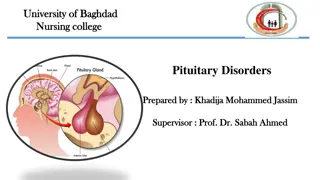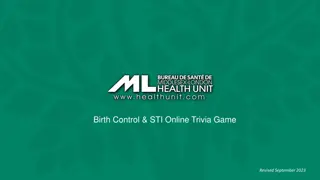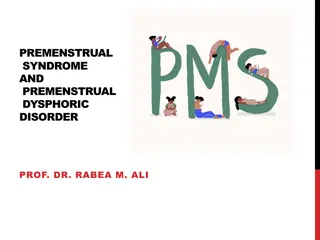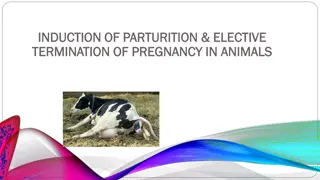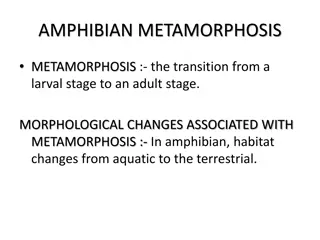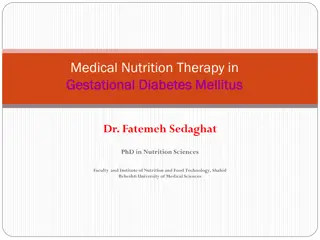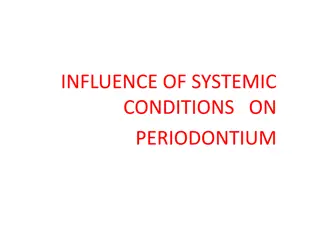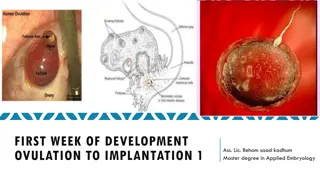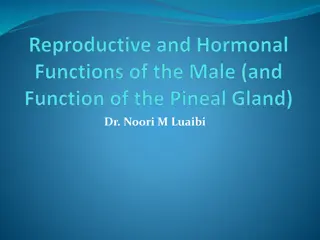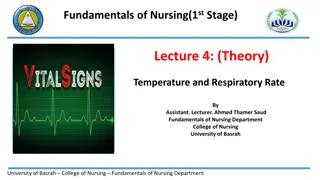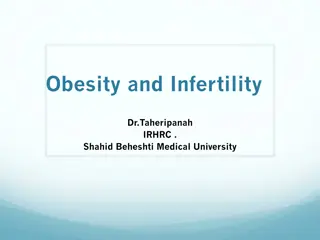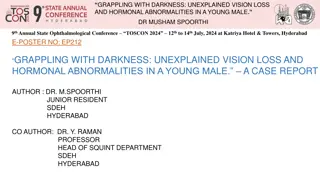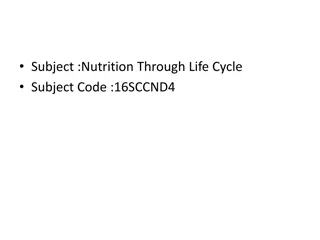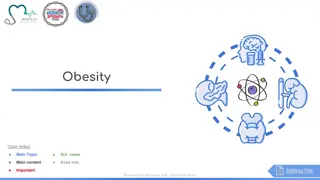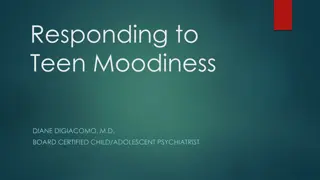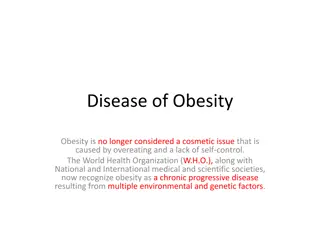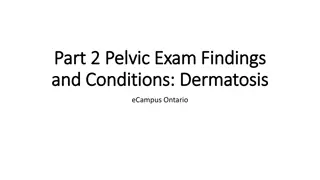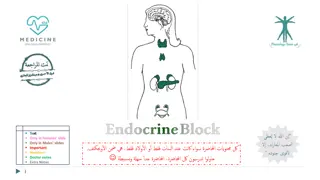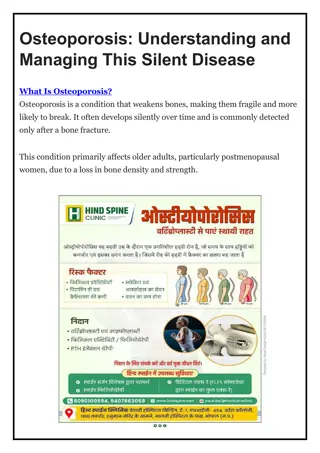Comprehensive Guide to Contraception and Birth Control Methods
Safe sex practices are crucial for preventing unplanned pregnancies and sexually transmitted infections (STIs). This guide discusses various contraception methods including barrier methods like male and female condoms, hormonal contraceptives such as oral pills, and their effectiveness rates. Cost,
0 views • 23 slides
Gynecological Considerations for Long-Duration Spaceflight
This study by the National Aeronautics and Space Administration (NASA) discusses the potential effects of microgravity and space radiation on gynecological health during long-duration spaceflight. Topics covered include normal menstruation, fertility, gynecologic pathology, and the impact of hormona
0 views • 28 slides
Understanding Shock: Causes, Symptoms, and Stages
Shock is a critical condition caused by an imbalance between cellular oxygen supply and demand, leading to organ dysfunction. Compensatory responses include increased heart rate, vasoconstriction, and hormonal adjustments. Recognizable features of shock include tachycardia, hypotension, cool clammy
3 views • 27 slides
Pituitary Disorders
Pituitary disorders, often caused by tumors, can disrupt hormone production leading to various symptoms like weight gain, vision problems, and hormonal imbalances. The pituitary gland plays a crucial role in regulating bodily functions through hormone secretion. Factors such as tumor growth, head in
0 views • 25 slides
Understanding Hyperemesis Gravidarum: Causes, Symptoms, and Treatment
Hyperemesis gravidarum is a severe form of nausea and vomiting during pregnancy, affecting around 27% to 52% of women. The condition typically starts between the 6th to 8th week of pregnancy and is linked to hormonal changes. Risk factors include family history, obesity, and young age at pregnancy.
4 views • 10 slides
Birth Control & STI Online Trivia Game - September 2023
Online trivia game on birth control, STIs, and emergency contraceptives with questions ranging from basic knowledge to in-depth details. Topics include hormonal contraceptives, storing condoms, mechanisms of hormonal birth control, and types of contraceptive methods. Players can test their knowledge
0 views • 18 slides
Understanding Combined Hormonal Contraceptives for Family Planning
Explore the world of combined hormonal contraceptives in this informative course. Learn about different methods, effectiveness, benefits, side effects, and eligibility criteria. Discover how to enhance the effectiveness of your chosen method and compare it with other family planning options. Dive in
0 views • 77 slides
Understanding Premenstrual Syndrome (PMS) and Its Impact
Premenstrual syndrome (PMS) is a common condition experienced by many women before their menstrual cycle. Symptoms include bloating, headaches, and moodiness. Cyclic hormonal changes and chemical fluctuations in the brain play a role in PMS. Factors like weight, exercise, stress, and diet can worsen
1 views • 38 slides
Hormonal Control in Animals: GCSE Biology Lesson
Explore the fascinating world of hormonal control in animals through this GCSE Biology lesson. Learn about hormones, the endocrine system, glands, and their roles in maintaining homeostasis. Understand the advantages and disadvantages of hormonal coordination, and study specific hormones and their f
0 views • 29 slides
Understanding Induction of Parturition in Animals
Explore the process of inducing and terminating parturition in animals, including the hormonal changes associated with pregnancy, fetal nutritional demands, and indications for induction. Learn about the role of oxytocin, adrenal changes in fetuses, and various methods used for inducing parturition.
0 views • 28 slides
Can Niacinamide Serum Help with Hyperpigmentation Here's What Experts Say
Hyperpigmentation is a common skin concern that affects people of all ages and skin types. Characterized by dark patches or spots on the skin, hyperpigmentation can be caused by various factors, including sun exposure, inflammation, hormonal changes,
0 views • 5 slides
Amphibian Metamorphosis: A Dive into Developmental Changes
Amphibian metamorphosis marks the transition from larval aquatic life to adult terrestrial existence. The process involves morphological transformations including tail resorption, gill destruction, and skin structure changes. Key changes in urodeles (salamanders) and anurans (frogs/toads) are outlin
1 views • 6 slides
Understanding Breast Development and Changes in Females
The breast, a vital organ in the upper ventral region of the torso, undergoes significant changes during puberty, the menstrual cycle, pregnancy, and milk production. These changes are driven by hormonal fluctuations, primarily estrogen and progesterone, resulting in the growth of milk ducts, format
0 views • 68 slides
Understanding Hyperemesis Gravidarum: Symptoms, Complications, and Management
Hyperemesis gravidarum is a severe condition in pregnancy characterized by intractable nausea and vomiting, resulting in fluid and electrolyte imbalances, nutritional disturbances, and physical and psychological debilitation. The exact cause is unknown, but factors like hormonal changes, genetics, a
0 views • 22 slides
Gestational Diabetes Mellitus: Overview and Risk Factors
Gestational Diabetes Mellitus (GDM) is defined as any level of glucose intolerance first detected during pregnancy, affecting approximately 7% of pregnancies globally. In Iran, GDM prevalence varies between 1.3% to 10%. Factors like age, BMI, weight gain, and family history influence GDM development
8 views • 50 slides
Understanding Reproductive Disorder Diseases and Hormonal Infertility in Simple Language
Reproductive disorders can lead to infertility or sterility in animals, affecting their ability to reproduce. Causes include anatomical, functional, infectious, and management factors. Hormonal infertility may result from issues like cystic ovaries, delayed ovulation, or inactive ovaries. Conditions
0 views • 14 slides
Influence of Systemic Conditions on Periodontium
Systemic diseases, disorders, and conditions can affect the periodontium by impairing the host's barrier function and immunity, leading to periodontal destruction. Endocrine disorders like diabetes mellitus and hormonal changes, as well as female sex hormones during puberty, menstruation, pregnancy,
0 views • 20 slides
Types of Birth Control Methods and Their Effectiveness
Explore the different types of birth control available, including abstinence, hormonal methods, barrier methods, and permanent methods. Learn about the effectiveness rates, how they work, and their pros and cons to make an informed decision about contraception. From hormonal options like pills, patc
0 views • 23 slides
Overview of the First Week of Development from Ovulation to Implantation
The first week of development after ovulation involves key processes like fertilization, cleavage, and blastocyst formation. It begins with the maturation of the primary oocyte in the follicle, leading to ovulation and potential fertilization. During this period, hormonal changes in the ovarian cycl
0 views • 21 slides
Understanding the Physiology of Labor in Pregnancy
Labor, also known as parturition, is the process of uterine contractions leading to the expulsion of the fetus. Various hormonal changes, including increased estrogen levels, play a crucial role in triggering and regulating labor. The progression from a quiescent uterus to active contractions involv
0 views • 29 slides
Physiology of Labor: Onset and Key Hormonal Changes
Labor, or parturition, involves uterine contractions leading to the fetus's expulsion. Factors triggering labor include hormonal changes like increased estrogen and decreased progesterone, which stimulate uterine muscle activity. Telocytes play a role in spontaneous uterine activity, while oxytocin
0 views • 36 slides
PEIA Open Enrollment Plan Year 2023 - Important Updates
PEIA Open Enrollment for the Plan Year 2023 is scheduled from April 2 to May 15. Changes made during this period will be effective from July 1. Benefit Coordinators must approve any changes by May 20. Members can make changes by visiting the PEIA website, calling the helpline, or filling out forms o
0 views • 36 slides
Understanding Male Reproductive and Hormonal Functions
The male reproductive system plays a crucial role in spermatogenesis, sexual performance, and hormonal regulation. Spermatogenesis is a complex process involving the formation of sperm cells from spermatogonia, which then mature through distinct stages. The anatomical structures involved, such as th
0 views • 47 slides
Understanding Body Temperature Regulation in Nursing Practice
Body temperature regulation is a vital aspect of nursing care, involving the balance between heat production and loss. The core body temperature is controlled by the hypothalamus, responding to thermal receptors and hormonal cues to maintain homeostasis. Heat production mechanisms such as metabolism
1 views • 31 slides
Understanding Puberty: A Guide for Girls
Puberty is a time of growth and change, typically occurring between 9 to 16 years of age for girls. It is marked by hormonal changes that lead to various physical and emotional transformations. These changes include acne, body odor, breast development, menstrual periods, growth spurts, body hair gro
0 views • 11 slides
Understanding Dry Eye: Causes, Symptoms, and Diagnosis
Dry eye is a common condition that occurs when your eyes do not produce enough tears or produce tears with the improper chemical composition. This can result from various factors such as aging, hormonal changes, medications, and environmental irritants. Symptoms include stinging, gritty sensation, f
0 views • 13 slides
Impact of Obesity on Fertility and Reproduction: A Comprehensive Overview
Obesity is a global epidemic impacting fertility in both men and women. It affects natural reproductive potential, infertility treatments, pregnancy outcomes, and child health. The pathophysiology involves endocrine changes, insulin resistance, and hormonal imbalances. Obesity can lead to irregular
0 views • 44 slides
Unexplained Vision Loss and Hormonal Abnormalities in Young Male - A Case Report
A case report presented at the 9th Annual State Ophthalmological Conference TOSCON 2024 discusses a young male patient grappling with unexplained vision loss and hormonal abnormalities. The patient exhibited symptoms of headache, diminished vision in the left eye, and an unusual head-turning behavio
0 views • 6 slides
Understanding Pregnancy Stages and Changes
Discover the three stages of pregnancy - first, second, and third trimester - lasting a total of 40 weeks. From conception to birth, delve into the physical and emotional changes a woman may experience, including hormonal fluctuations and adjustments in daily routines.
0 views • 41 slides
Understanding Obesity: Risk Factors, Fat Deposition, and Hormonal Control
Obesity is a condition characterized by excess body fat accumulation, impacting overall health and increasing the risk of various complications such as diabetes, heart disease, and cancer. This content delves into defining obesity based on BMI, exploring anatomic and biochemical differences in fat d
0 views • 12 slides
Understanding Teen Moodiness: A Psychiatrist's Insight into Adolescence
Adolescence brings significant hormonal changes that impact teens' emotions and behaviors. This phase, characterized by mood swings and impulsive actions, is a natural part of development influenced by brain structure alterations and psychological adaptations. As adolescents navigate the journey of
0 views • 13 slides
Understanding the Disease of Obesity: A Multifactorial Condition
Obesity is no longer considered a cosmetic issue but recognized as a chronic progressive disease influenced by genetic, environmental, and behavioral factors. It requires lifelong treatment due to its costly impact on health and society. The condition is measured using Body Mass Index (BMI) categori
0 views • 48 slides
Case Discussion: Post-Menopausal Bleeding in a 65-year-old Woman
Mrs. Pauline, a 65-year-old woman presenting with post-menopausal bleeding for the past 4 months, without associated symptoms, history of recent weight changes, or hormonal therapy. Her menstrual and obstetric histories, along with past medical and surgical history, are significant. Further evaluati
0 views • 22 slides
Understanding Stress Response and its Impact on the Body
Stressful situations trigger a cascade of physiological changes known as the "fight-or-flight" response. The body's hormonal and physiological reactions help in coping with threats, but overreactions to non-life-threatening stressors can occur. The brain's command center, the hypothalamus, communica
0 views • 10 slides
Genitourinary Syndrome of Menopause (GSM) - Symptoms and Management Overview
Genitourinary syndrome of menopause (GSM) encompasses urovaginal symptoms associated with hormonal changes during menopause. Symptoms include vaginal dryness, burning, itching, dyspareunia, urinary urgency, and more. Thin, pale epithelium and tissue changes are common. Management involves various tr
0 views • 14 slides
Understanding Parathyroid Disorders - Calcium Metabolism and Hormonal Regulation
This presentation covers the functions of calcium, calcium metabolism, bone physiology, and hormonal regulation of calcium metabolism focusing on parathyroid hormone, calcitonin, and Vitamin D. It discusses hypo and hyperparathyroidism in detail, including clinical manifestations and treatment optio
0 views • 15 slides
Understanding Typical Adolescent Development and Mental Health Concerns
Adolescence is a period marked by significant physical, emotional, and social changes. During early adolescence (10-13), children experience rapid growth and increased privacy needs. In middle adolescence (14-17), teens explore romantic relationships and seek independence. It's crucial to differenti
0 views • 16 slides
Rational Management of Metastatic Castration-Resistant Prostate Cancer: Treatment Insights and Options
Experts discussed various treatment options for a 60-year-old patient with mCRPC, including switching to Lutetium therapy after progression on Apalutamide. Genetic testing, avoiding back-to-back hormonal therapies, and considering novel AR-blockers like Lutetium-PSMA and PARP inhibitors were highlig
0 views • 6 slides
Ayurvedic Phal Ghrit Key To Ending Women’s Hormonal Fluctuations
Punarvasu Ayurveda, a trusted name in holistic healing, brings the potent Ayurvedic Phal Ghrit to life. Crafted with precision, it supports hormonal balance in women, alleviating fluctuations naturally. Enriched with time-tested herbs, \nSourceLink[\
0 views • 5 slides
Osteoporosis - Hind Spine Clinic
Osteoporosis is a condition that weakens bones, making them brittle and prone to fractures. It occurs when bone density decreases due to factors like aging, hormonal changes, poor nutrition, or a sedentary lifestyle. Common fracture sites include the
3 views • 4 slides



